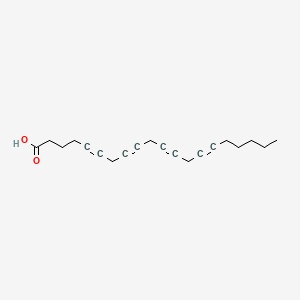| Weber PC et al. |
Possible significance of renal prostaglandins for renin release and blood pressure control. |
1980 |
Adv Prostaglandin Thromboxane Res |
pmid:6989178
|
| Nemeth EF and Douglas WW |
Differential inhibitory effects of the arachidonic acid analog ETYA on rat mast cell exocytosis evoked by secretagogues utilizing cellular or extracellular calcium. |
1980 |
Eur. J. Pharmacol. |
pmid:6161012
|
| Boeynaems JM et al. |
In vitro effects of arachidonic acid and of inhibitors of its metabolism on the dog thyroid gland. |
1980 |
Prostaglandins |
pmid:6247748
|
| O'Flaherty JT |
Involvement of bivalent cations and arachidonic acid in neutrophil aggregation. |
1980 |
Inflammation |
pmid:6771213
|
| Goetzl EJ |
A role for endogenous mono-hydroxy-eicosatetraenoic acids (HETEs) in the regulation of human neutrophil migration. |
1980 |
Immunology |
pmid:6776039
|
| Lazar JD and Whorton AR |
Prostaglandin mediation of potassium effects on renin release. |
1980 |
Life Sci. |
pmid:6777616
|
| Daniel EE et al. |
Prostaglandins and myogenic control of tension in lower esophageal sphincter in vitro. |
1979 |
Prostaglandins |
pmid:379920
|
| Gordon D et al. |
Effects of prostaglandins E2 and I2 on human lymphocyte transformation in the presence and absence of inhibitors of prostaglandin biosynthesis. |
1979 |
Br. J. Pharmacol. |
pmid:387146
|
| Page Thomas DP and Phillips NC |
Intra-articular liposomal therapy. |
1979 |
Front Biol |
pmid:499601
|
| O'Flaherty JT et al. |
Role of arachidonic acid derivatives in neutrophil aggregation: a hypothesis. |
1979 |
Prostaglandins |
pmid:504694
|
| Bokoch GM and Reed PW |
Inhibition of the neutrophil oxidative response to a chemotactic peptide by inhibitors of arachidonic acid oxygenation. |
1979 |
Biochem. Biophys. Res. Commun. |
pmid:508315
|
| Sullivan TJ and Parker CW |
Possible role of arachidonic acid and its metabolites in mediator release from rat mast cells. |
1979 |
J. Immunol. |
pmid:762430
|
| Tobias LD and Hamilton JG |
The effect of 5,8,11,14-eicosatetraynoic acid on lipid metabolism. |
1979 |
Lipids |
pmid:106197
|
| Patterson R et al. |
Ionophore and arachidonic acid stimulation of airway responses in rhesus monkeys. |
1979 |
J. Clin. Invest. |
pmid:109472
|
| Wilson AG et al. |
Covalent binding of intermediates formed during the metabolism of arachidonic acid by human platelet subcellular fractions. |
1979 |
Prostaglandins |
pmid:119279
|
| Caschetto S et al. |
Prostaglandins and the contractile function of the human oviductal ampulla. |
1979 |
Gynecol. Obstet. Invest. |
pmid:119675
|
| Pickett WC et al. |
Inhibition by non-steroidal anti-inflammatory agents of the ascorbate-induced elevations of platelet cyclic AMP levels. |
1979 |
J Cyclic Nucleotide Res |
pmid:90062
|
| Sobotka AK et al. |
Indomethacin, arachidonic acid metabolism and basophil histamine release. |
1979 |
Monogr Allergy |
pmid:91953
|
| Ford-Hutchinson AW et al. |
The aggregation of rat neutrophils by arachidonic acid: a possible bioassay for lipoxygenase activity. |
1979 |
J. Pharm. Pharmacol. |
pmid:43380
|
| Parker CW et al. |
Characterization of the two major species of slow reacting substance from rat basophilic leukemia cells as glutathionyl thioethers of eicosatetraenoic acids oxygenated at the 5 position. Evidence that peroxy groups are present and important for spasmogenic activity. |
1979 |
Prostaglandins |
pmid:44377
|
